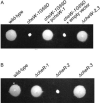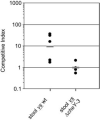Cholera stool bacteria repress chemotaxis to increase infectivity
- PMID: 16573690
- PMCID: PMC2754204
- DOI: 10.1111/j.1365-2958.2006.05096.x
Cholera stool bacteria repress chemotaxis to increase infectivity
Abstract
Factors that enhance the transmission of pathogens are poorly understood. We show that Vibrio cholerae shed in human 'rice-water' stools have a 10-fold lower oral infectious dose in an animal model than in vitro grown V. cholerae, which may aid in transmission during outbreaks. Furthermore, we identify a bacterial factor contributing to this enhanced infectivity: The achievement of a transient motile but chemotaxis-defective state upon shedding from humans. Rice-water stool V. cholerae have reduced levels of CheW-1, which is essential for chemotaxis, and were consequently shown to have a chemotaxis defect when tested in capillary assays. Through mutational analyses, such a state is known to enhance the infectivity of V. cholerae. This is the first report of a pathogen altering its chemotactic state in response to human infection in order to enhance its transmission.
Figures





References
-
- Adler J. A method for measuring chemotaxis and use of the method to determine optimum conditions for chemotaxis by Escherichia coli. J Gen Microbiol. 1973;74:77–91. - PubMed
-
- Allweiss B, Dostal J, Carey KE, Edwards TF, Freter R. The role of chemotaxis in the ecology of bacterial pathogens of mucosal surfaces. Nature. 1977;266:448–450. - PubMed
-
- Berg HC, Brown DA. Chemotaxis in Escherichia coli analysed by three-dimensional tracking. Nature. 1972;239:500–504. - PubMed
Publication types
MeSH terms
Substances
Grants and funding
LinkOut - more resources
Full Text Sources
Other Literature Sources
Medical

